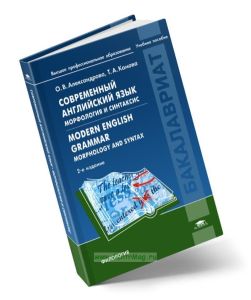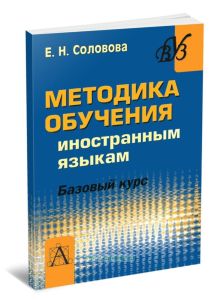
- Артикул:00-01006796
- Автор: Александрова О.В., Комова Т.А.
- ISBN: 978-5-7695-9825-8
- Тираж: 1000 экз.
- Обложка: Твердый переплет
- Издательство: Издательский центр "Академия" (все книги издательства)
- Город: Москва
- Страниц: 224
- Формат: 60х90/16
- Год: 2013
- Вес: 357 г
- Серия: Учебное пособие для ВУЗов (все товары серии)
- Профессиональное образование
Учебное пособие создано в соответствии с Федеральными государственными образовательными стандартами по направлениям подготовки 032700 - Филология (квалификация «бакалавр»), 050100 - Педагогическое образование (профиль «иностранный язык», квалификация «бакалавр»).
В учебном пособии предлагается функциональный подход к изложению основных проблем грамматической теории современного английского языка. Все теоретические вопросы объясняются с привлечением иллюстративного материала из аутентичных источников разных функциональных стилей английского языка.
Для студентов учреждений высшего профессионального образования.
Contents
Preface
Part 1. Morphology
Chapter 1. Morphology, its definition and its place among other linguistic disciplines
1.1. The units and processes of the morphological level
1.2. Morphemes
1.3. Morphological processes
1.3.1. Processes affecting grammatical form
1.3.2. Processes affecting grammatical content
1.4. Analytical forms
Chapter 2. Categorisation in morphology
2.1. Categorisation: categories, categorial forms
2.2. Grammatical categories
2.3. On dialectical unity of synchrony and diachrony in a morphological analysis
2.4. On categorisation as a dynamic process in terms of synchrony
2.5. On categorematic vs syncategorematic words in Modern English
2.6. Categorisation in open-class system
2.7. On deixis as a category
2.8. Closed-system classification
2.8.1. Articles
2.8.2. Articles with uncountable vs countable nouns
2.8.3. Syncategorematic vs categorematic Verbs
Chapter 3. Parts-of-speech classification
3.1. Pronouns. Pro-words. Their definition and specificity. Types of pronouns and their grammatical categories
3.1.1. Personal pronouns
3.1.2. Interrogative pronouns
3.1.3. Reciprocal pronouns
3.1.4. Demonstrative pronouns
3.1.5. Indefinite pronouns
3.1.6. Negative pronouns
3.2. Prepositions. Semantics and functions of prepositions
3.3. Conjunctions. Conjunctions of coordination and subordination. Morphological structure of conjunctions and their semantics
3.4. Interjections: their referential content and classification
3.5. Adjectives
3.6. Adverbs
3.7. Nouns. Types of nouns, grammatical categories of nouns
3.7.1. Case
3.7.2. Number
3.7.3. Gender
3.8. Verbs. Modals, auxiliaries, notional verbs and their grammatical-morphological categories: mood, tense, aspect, voice, taxis, person, number
3.8.1. Modals
3.8.2. Auxiliary verbs
3.8.3. Notional verbs and their grammatical-morphological categories
3.8.4. The category of mood
3.8.5. Indicative mood. The category of tense
3.8.6. The category of aspect
3.8.7. The category of voice
3.8.8. Taxis. The category of simultaneity-anteriority
3.8.9. The functional-semantic intersection of the categories of tense and taxis in Modern English
3.8.10. The category of person
3.8.11. The category of number
3.9. Numerals. Cardinal and ordinal numerals, their morphological structure and syntactic properties: numerals and nouns, numerals and adjectives. Idiomaticity of collocations based on numerals. Numerals and major mathematic operations of addition, subtraction, multiplication and division. Fractions, percentage and interest
Chapter 4. Morphology and syntax
4.1. The category of enunciation. Tag questions
4.2. Negation and phraseology
4.3. Negation and translation
Part II. Syntax and discourse
Chapter 1. The subject of syntax
1.1. General remarks
1.2. Syntax and syntactic units
Chapter 2. The ultimate and the consummate units of speech
Chapter 3. Minor syntax
3.1. What is “word-combination”
3.2. Types of word-combinations
3.3. Methods of study of word- combinations
Chapter 4. Syntax and prosody
4.1. Pausation
4.2. Tonicity
4.3. Tempo
4.4. Loudness
Chapter 5. Syntax and punctuation
5.1. Comma
5.2. Semicolon
5.3. Colon
5.4. Dash
5.5. Exclamation and question marks
5.6. Parenthesis
Chapter 6. Simple sentence and its parts
6.1. Simple and multiple sentences
6.2. Types of simple sentences
6.3. Simple sentence and its parts
6.4. Syntactic diarhemes
6.4.1. Completive bond
6.4.2. Copulative syntactic bond
6.4.3. Predicative bond
6.4.4. Content plane
6.4.5. Prosody and punctuation as the reflection of the syntactic construction of speech
Chapter 7. Multiple sentences
7.1. Compound sentences
7.2. Complex sentences
7.3. There-sentences
7.4. Cleft sentences
Chapter 8. Predication
8.1. Main units of predication
8.2. The expression of predication
8.3. Syntactic dynamism on the level of discourse
8.4. Predicative or predicating?
8.5. Grammatical vs dynamic approach to the study of the sentence
Chapter 9. Parenthesis
9.1. The notion of parenthetical insertion
9.2. Categories and types of parenthesis
9.3. Functions of parenthetical insertions
9.4. Stylistic functions of parenthesis
Chapter 10. The pragmatic approach to the study of grammar
10.1. Grammar in use
10.2. Grammar and pragmatics
10.3. Making texts
Chapter 11. Discourse and syntax
11.1. Phrasing
11.2. Rhythm
11.3. Parcellation
11.4. Syntactic division of a text as the stylistic device
Chapter 12. Cognitive approach to the study of language
12.1. General remarks
12.2. Discourse as the important subject of cognitive study
Questions and tasks for self-control
Term examination questions
Index of terms
Literature








